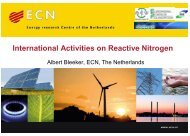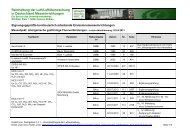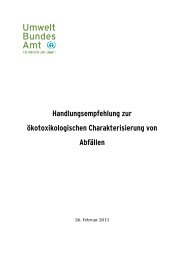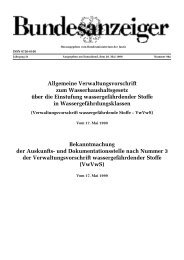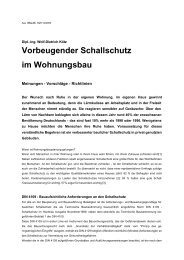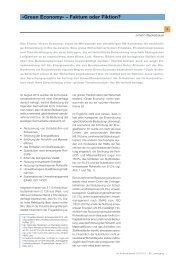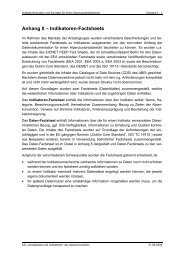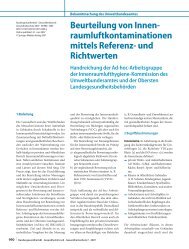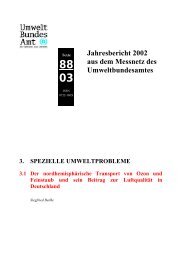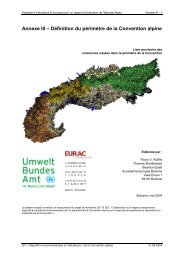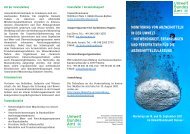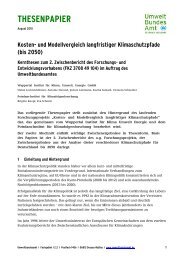VDI 4203 - Umweltbundesamt
VDI 4203 - Umweltbundesamt
VDI 4203 - Umweltbundesamt
Sie wollen auch ein ePaper? Erhöhen Sie die Reichweite Ihrer Titel.
YUMPU macht aus Druck-PDFs automatisch weboptimierte ePaper, die Google liebt.
Frühere Ausgabe: 4.00 Entwurf, deutsch<br />
Former edition: 4/00 draft, in German only<br />
Zu beziehen durch / Available from Beuth Verlag GmbH, 10772 Berlin – Alle Rechte vorbehalten / All rights reserved © Verein Deutscher Ingenieure, Düsseldorf 2001<br />
ICS 13.040.20<br />
VEREIN<br />
DEUTSCHER<br />
INGENIEURE<br />
<strong>VDI</strong>-RICHTLINIEN<br />
Prüfpläne für automatische Messeinrichtungen<br />
Grundlagen<br />
Der Entwurf dieser Richtlinie wurde mit Ankündigung im Bundesanzeiger<br />
einem öffentlichen Einspruchsverfahren unterworfen.<br />
Die deutsche Version dieser Richtlinie ist verbindlich.<br />
Inhalt Seite<br />
Vorbemerkung . . . . . . . . . . . . . . . . . . . 2<br />
Einleitung. . . . . . . . . . . . . . . . . . . . . . 3<br />
1 Anwendungsbereich . . . . . . . . . . . . . . 4<br />
2 Begriffe und Definitionen. . . . . . . . . . . . 5<br />
3 Bestimmungen für die Eignungsprüfung . . . 6<br />
3.1 Allgemeines . . . . . . . . . . . . . . . . . 6<br />
3.2 Änderung eignungsgeprüfter<br />
Messeinrichtungen. . . . . . . . . . . . . . 7<br />
4 Prüfbericht. . . . . . . . . . . . . . . . . . . . 8<br />
Anhang Anforderungen an die Prüfinstitute . . . . 8<br />
Schrifttum . . . . . . . . . . . . . . . . . . . . . . 10<br />
Testing of automated measuring systems<br />
General concepts<br />
Kommission Reinhaltung der Luft (KRdL) im <strong>VDI</strong> und DIN – Normenausschuss<br />
Arbeitsgruppe Prüfpläne<br />
Ausschuss Messtechnische Sonderfragen<br />
<strong>VDI</strong>/DIN-Handbuch Reinhaltung der Luft, Band 5<br />
<strong>VDI</strong> <strong>4203</strong><br />
Blatt 1 / Part 1<br />
Oktober 2001<br />
October 2001<br />
Ausg. deutsch/englisch<br />
Issue German/English<br />
The draft of this guideline has been subject to public scrutiny<br />
after announcement in the Bundesanzeiger (Federal Gazette).<br />
No guarantee can be given with respect to the English translation.<br />
The German version of this guideline shall be taken as<br />
authoritative.<br />
Contents Page<br />
Preliminary note . . . . . . . . . . . . . . . . . . 2<br />
Introduction . . . . . . . . . . . . . . . . . . . . 3<br />
1 Scope . . . . . . . . . . . . . . . . . . . . . . . 4<br />
2 Terms and definitions . . . . . . . . . . . . . . 5<br />
3 Suitability testing requirements . . . . . . . . 6<br />
3.1 General . . . . . . . . . . . . . . . . . . . . 6<br />
3.2 Modifications to suitability-tested measuring<br />
systems . . . . . . . . . . . . . . . . . . . . 7<br />
4 Test report . . . . . . . . . . . . . . . . . . . . 8<br />
Annex Requirements on test institutes . . . . . . . 8<br />
Bibliography . . . . . . . . . . . . . . . . . . . . .10
– 2 – <strong>VDI</strong> <strong>4203</strong> Blatt 1 / Part 1<br />
Vorbemerkung<br />
In der Kommission Reinhaltung der Luft (KRdL) im<br />
<strong>VDI</strong> und DIN – Normenausschuss – erarbeiten Fachleute<br />
aus Wissenschaft, Industrie und Verwaltung in<br />
freiwilliger Selbstverantwortung <strong>VDI</strong>-Richtlinien<br />
und DIN-Normen zum Umweltschutz. Diese beschreiben<br />
den Stand der Technik bzw. Stand der Wissenschaft<br />
in der Bundesrepublik Deutschland und<br />
dienen als Entscheidungshilfen bei der Erarbeitung<br />
und Anwendung von Rechts- und Verwaltungsvorschriften.<br />
Die Arbeitsergebnisse der KRdL fließen<br />
ferner als gemeinsamer deutscher Standpunkt in die<br />
europäische technische Regelsetzung bei CEN<br />
(Europäisches Komitee für Normung) und in die<br />
internationale technische Regelsetzung bei ISO<br />
(Internationale Organisation für Normung) ein.<br />
Folgende Themenschwerpunkte werden in vier Fachbereichen<br />
behandelt:<br />
Fachbereich I<br />
„Umweltschutztechnik“<br />
Produktionsintegrierter Umweltschutz; Verfahren<br />
und Einrichtungen zur Emissionsminderung;<br />
ganzheitliche Betrachtung von Emissionsminderungsmaßnahmen<br />
unter Berücksichtigung von<br />
Luft, Wasser und Boden; Emissionswerte für<br />
Stäube und Gase; anlagenbezogene messtechnische<br />
Anleitungen; Handhabung brennbarer<br />
Stäube; Minderung der Exposition gegenüber luftfremden<br />
Stoffen am Arbeitsplatz; Umweltschutzkostenrechnung<br />
Fachbereich II „Umweltmeteorologie“<br />
Ausbreitung von Luftverunreinigungen in der<br />
Atmosphäre; störfallbedingte Freisetzungen;<br />
mikro- und mesoskalige Windfeldmodelle; Wechselwirkung<br />
zwischen Atmosphäre und Oberflächen;<br />
meteorologische Messungen; angewandte<br />
Klimatologie; Lufthygienekarten; human-biometeorologische<br />
Bewertung von Klima und Lufthygiene;<br />
Übertragung meteorologischer Daten<br />
Fachbereich III „Umweltqualität“<br />
Wirkung von Luftverunreinigungen auf Mensch,<br />
Tier, Pflanze, Boden, Werkstoffe und Atmosphäre;<br />
wirkungsbezogene Mess- und Erhebungsverfahren;<br />
Erfassung und Wirkung mikrobieller Luftverunreinigungen;<br />
Olfaktometrie; Umweltsimulation<br />
Fachbereich IV<br />
„Umweltmesstechnik“<br />
Emissions- und Immissionsmesstechnik für anorganische<br />
und organische Gase sowie für Partikel;<br />
optische Fernmessverfahren; Messen von Innenraumluftverunreinigungen;<br />
Messen von Boden-<br />
All rights reserved © Verein Deutscher Ingenieure, Düsseldorf 2001<br />
Preliminary note<br />
In the Commission on Air Pollution Prevention of<br />
<strong>VDI</strong> and DIN – Standards Committee (KRdL) experts<br />
from science, industry and administration, acting<br />
on their own responsibility, establish <strong>VDI</strong> guidelines<br />
and DIN Standards in the field of environmental<br />
protection. These describe the state of the art in science<br />
and technology in the Federal Republic of Germany<br />
and serve as a decision-making aid in the preparatory<br />
stages of legislation and application of legal<br />
regulations and ordinances. KRdL's working results<br />
are also considered as the common German point of<br />
view in the establishment of technical rules on the<br />
European level by CEN (European Committee for<br />
Standardization) and on the international level by<br />
ISO (International Organization for Standardization).<br />
The following topics are dealt with in four subdivisions:<br />
Subdivision I<br />
”Environmental Protection Techniques“<br />
Integrated pollution prevention and control for installations;<br />
procedures and installations for emission<br />
control; overall consideration of measures for<br />
emission control with consideration given to the<br />
air, water and soil; emission limits for dusts and<br />
gases; plant-related measurement instructions; the<br />
safe processing of combustible dusts; reduction of<br />
exposure to air pollutants in the workplace atmosphere,<br />
environmental industrial cost accounting<br />
Subdivision II ”Environmental Meteorology“<br />
Dispersion of pollutants in the atmosphere; emissions<br />
from accidental releases; micro- and mesoscale<br />
wind field models; interaction between the<br />
atmosphere and surfaces; meteorological measurements;<br />
applied climatology; air pollution maps;<br />
human-biometeorological evaluation of climate<br />
and air hygiene; transfer of meteorological data<br />
Subdivision III ”Environmental Quality“<br />
Effects of air pollutants on man, farm animals,<br />
vegetation, soil, materials, and the atmosphere;<br />
methods for the measurement and evaluation of effects;<br />
determination of microbial air pollutants and<br />
their effects; olfactometry; environmental simulation<br />
Subdivision IV<br />
”Environmental Measurement Techniques“<br />
Techniques for emission and ambient air measurements<br />
of inorganic and organic gases as well as<br />
particulate matter; optical open-path measurement
Alle Rechte vorbehalten © Verein Deutscher Ingenieure, Düsseldorf 2001 <strong>VDI</strong> <strong>4203</strong> Blatt 1 / Part 1 – 3 –<br />
luftverunreinigungen; Verfahren zur Herstellung<br />
von Referenzmaterialien; Prüfpläne für Messgeräte;<br />
Validierungsverfahren; Messplanung; Auswerteverfahren;<br />
Qualitätssicherung<br />
Die Richtlinien und Normen werden zunächst als<br />
Entwurf veröffentlicht. Durch Ankündigung im Bundesanzeiger<br />
und in der Fachpresse erhalten alle interessierten<br />
Kreise die Möglichkeit, sich an einem<br />
öffentlichen Einspruchsverfahren zu beteiligen.<br />
Durch dieses Verfahren wird sichergestellt, dass<br />
unterschiedliche Meinungen vor Veröffentlichung<br />
der endgültigen Fassung berücksichtigt werden können.<br />
Die Richtlinien und Normen sind in sechs Bänden<br />
des <strong>VDI</strong>/DIN-Handbuches Reinhaltung der Luft zusammengefasst.<br />
Einleitung<br />
Um eine einheitliche Qualität bei der kontinuierlichen<br />
Messung von Emissionen bzw. der Luftqualität<br />
sicherzustellen, wird in dem das Bundes-Immissionsschutzgesetz<br />
untersetzenden Regelwerk, also den<br />
Verordnungen zur Durchführung des Bundes-<br />
Immissionsschutzgesetzes [G1] und Verwaltungsvorschriften,<br />
der Einsatz geeigneter Mess- und Auswerteeinrichtungen<br />
gefordert. Die Anforderungen an<br />
solche Mess- bzw. Auswerteeinrichtungen sind in<br />
Richtlinien über die “Bundeseinheitliche Praxis bei<br />
der Überwachung” von Emissionen oder Immissionen<br />
und in anderen technischen Regeln (siehe<br />
Tabelle 1) festgelegt.<br />
Der Weg der Formulierung von Mindestanforderungen<br />
– im Gegensatz zur Festsetzung detaillierter<br />
Verfahren – wurde eingeschlagen, um messtechnische<br />
Neuentwicklungen nicht zu behindern.<br />
Die Mindestanforderungen legen die notwendigen<br />
Parameter fest, um die Aufgaben, die durch die rechtlichen<br />
Vorgaben gestellt sind, erfüllen zu können.<br />
Wie diese erfüllt werden, bleibt dem Gerätehersteller<br />
unbenommen.<br />
Der Einsatz eignungsgeprüfter Messeinrichtungen<br />
erleichtert die Arbeit der Genehmigungs- bzw. Überwachungsbehörden,<br />
die so nicht die Eignung der notwendigen<br />
Messtechnik für die jeweilige Messaufgabe<br />
prüfen müssen. Weiterhin gibt der Einsatz eignungsgeprüfter<br />
Messeinrichtungen dem Anwender<br />
die weitgehende Sicherheit, dass die Messeinrichtungen<br />
für die Messaufgabe ohne Probleme genutzt werden<br />
können.<br />
methods; measurement of indoor air pollutants,<br />
measurement of soil air pollutants; procedures for<br />
establishing reference material; test procedures for<br />
measurement devices; validation procedures;<br />
measurement planning; evaluation methods; quality<br />
assurance<br />
The guidelines and standards are first published as<br />
drafts. These are announced in the Bundesanzeiger<br />
(Federal Gazette) and in professional publications in<br />
order to give all interested parties the opportunity to<br />
participate in an official objection procedure. This<br />
procedure ensures that differing opinions can be considered<br />
before the final version is published.<br />
The guidelines and standards are published in the sixvolume<br />
<strong>VDI</strong>/DIN Reinhaltung der Luft (Air Pollution<br />
Prevention) manual.<br />
Introduction<br />
To ensure uniform quality in continuous measurement<br />
of emissions and ambient air quality, the set of<br />
regulations underlying the German Federal Immission<br />
Control Act [G1], that is to say the Ordinances<br />
on the implementation of the German Federal Immission<br />
Control Act and General Administrative Provisions<br />
require the use of suitable measuring and evaluation<br />
systems. The requirements of such measuring<br />
and evaluation systems are set down in federal guidelines<br />
on emission and ambient air quality monitoring<br />
and in other technical rules (see Table 1).<br />
The method of formulating minimum requirements,<br />
in contrast to establishing detailed methods, has been<br />
proposed in order not to prevent developments in<br />
measurement technology. The minimum requirements<br />
specify the parameters which are required to be<br />
able to meet the objectives set by the legal provisions.<br />
The way in which these are met remains open to instrument<br />
manufacturers.<br />
The use of suitability-tested measuring systems facilitates<br />
the work of the authorization and monitoring<br />
authorities, which then do not need to test the performance<br />
of the measuring system required for the<br />
specific measurement task. In addition, the use of<br />
suitability-tested measuring systems gives the user<br />
the substantial security that the measuring equipment<br />
can be used without problem for the measurement<br />
task.
– 4 – <strong>VDI</strong> <strong>4203</strong> Blatt 1 / Part 1<br />
Tabelle 1. Einsatzbereiche für eignungsgeprüfte Messeinrichtungen<br />
All rights reserved © Verein Deutscher Ingenieure, Düsseldorf 2001<br />
Einsatzbereich Gesetzliche Grundlagen Anforderungen<br />
Emissionen<br />
Genehmigungsbedürftige Anlagen §29 BImSchG [G1]<br />
Nr. 3.2.3 TA Luft [G9]<br />
Richtlinien 1998 [G11]<br />
Großfeuerungsanlagen §25 13. BImSchV [G4] Richtlinien 1998 [G11]<br />
Verbrennungsanlagen für Abfall §11 17. BImSchV [G5] Richtlinien 1998 [G11]<br />
CKF-Anlagen: Chemisch-Reinigungen, Oberflächenbehandlung,<br />
Extraktion*<br />
§12 2. BImSchV [G3] Richtlinien 1993 [G12]<br />
Krematorien §7 27. BImSchV [G8] Richtlinien 1998 [G11]<br />
Kleinfeuerungsanlagen* §13 1. BImSchV [G2] Richtlinien 1997 [G13]<br />
Auswertung von Emissionsmessungen §25 13. BImSchV [G4]<br />
§11 17. BImSchV [G5]<br />
Nr. 3.2.3 TA Luft [G9]<br />
Richtlinien 1998 [G11]<br />
Emissionsfernüberwachung §31 BImSchG [G1] Richtlinien 1998 [G11]<br />
Schnittstellendefinition [T7]<br />
Immissionen<br />
Kontinuierliche Überwachung 22. BImSchV [G6] Richtlinien 1981 [G14]<br />
Verkehrsimmissionen Anhang I 23. BImSchV<br />
[G7]<br />
Messung in Untersuchungsgebieten Nr. 5.4 4. BImSchVwV<br />
[G10]<br />
Richtlinien 1981 [G14]<br />
DIN 33 963 [T2; T3]<br />
Richtlinien 1981 [G14]<br />
Messung der Vorbelastung Nr. 2.6.2 TA Luft [G9] Richtlinien 1981 [G14]<br />
* Für diese Anlagen werden auf Grund der Messaufgaben teilweise Messeinrichtungen eingesetzt, die mit den üblichen automatischen<br />
Messeinrichtungen nur bedingt vergleichbar sind. Die Forderung dieser Richtlinie sind hierauf sinngemäß anzuwenden.<br />
Die Prüfung solcher Messeinrichtungen wird von<br />
Prüfinstituten durchgeführt, an die hohe Anforderungen<br />
gestellt werden (siehe Anhang). Die Verfahren<br />
zur Prüfung der Messeinrichtungen werden in<br />
der vorliegenden Richtlinienreihe beschrieben.<br />
1 Anwendungsbereich<br />
Die Richtlinie <strong>VDI</strong> <strong>4203</strong> beschreibt die Verfahren,<br />
nach denen in Eignungsprüfungen die Einhaltung der<br />
Mindestanforderungen an automatische Messeinrichtungen<br />
zur Überwachung von Emissionen und<br />
Immissionen und Auswerteeinrichtungen zu prüfen<br />
ist. Blatt 1 behandelt Grundlagen der Prüfungen, das<br />
Verfahren der Eignungsprüfung und grundlegende<br />
Anforderungen an die Berichterstattung.<br />
In weiteren Blättern dieser Richtlinienreihe werden<br />
behandelt:<br />
Prüfprozeduren für Messeinrichtungen zur Messung<br />
von Emissionen<br />
Prüfprozeduren für Messeinrichtungen zur Messung<br />
von Immissionen<br />
spezifische Prüfprozeduren für Auswertesysteme<br />
Such measuring systems are tested by test institutes<br />
which are subject to strict requirements (see Annex).<br />
The methods for testing measuring systems is described<br />
in this series of <strong>VDI</strong> guidelines.<br />
1 Scope<br />
Guideline <strong>VDI</strong> <strong>4203</strong> describes the methods which are<br />
to be used in suitability testing for testing compliance<br />
with minimum requirements of automated measuring<br />
systems for monitoring emissions and ambient air<br />
quality as well as evaluation systems. Part 1 deals<br />
with fundamentals of testing, the methods of suitability<br />
testing and fundamental requirements of reporting.<br />
Further parts of this guideline will deal with:<br />
test procedures for measuring systems to measure<br />
emissions<br />
test procedures for measuring systems to measure<br />
ambient air quality<br />
specific test procedures for evaluation systems
Alle Rechte vorbehalten © Verein Deutscher Ingenieure, Düsseldorf 2001 <strong>VDI</strong> <strong>4203</strong> Blatt 1 / Part 1 – 5 –<br />
Table 1. Areas of use for suitability-tested measuring systems<br />
Area of use Legal basis Requirements<br />
Emissions<br />
Installations subject to licensing §29 BImSchG [G1]<br />
Nr. 3.2.3 TA Luft [G9]<br />
Die Richtlinie <strong>VDI</strong> <strong>4203</strong> gilt für alle Eignungsprüfungen<br />
von automatischen Messeinrichtungen<br />
und Auswertesystemen, deren Einsatz für Aufgaben<br />
im Bereich der Luftqualitätsüberwachung im geregelten<br />
Bereich vorgesehen ist. Die Anwendung im<br />
nicht geregelten Bereich wird empfohlen.<br />
Die Richtlinie <strong>VDI</strong> <strong>4203</strong> ist nicht anwendbar auf einzelne<br />
Komponenten von Messeinrichtungen (z. B.<br />
Analysator, Vorrichtungen zur Probenahme und Probenaufbereitung).<br />
2 Begriffe und Definitionen<br />
2.1 Dauertest<br />
Prüfung einer Messeinrichtung an einem Ort während<br />
eines zusammenhängenden Zeitraumes.<br />
2.2 Eignungsbekanntgabe<br />
Verwaltungsakt zur Bestätigung der Eignung der<br />
Messeinrichtung für Überwachungsaufgaben im gesetzlich<br />
geregelten Bereich.<br />
Anmerkung: Die Bekanntgabe erfolgt durch Veröffentlichung im<br />
Gemeinsamen Ministerialblatt der Bundesministerien.<br />
Guideline <strong>VDI</strong> <strong>4203</strong> applies to all suitability testing<br />
of automated measuring systems and evaluation systems<br />
whose use is intended for tasks in the field of air<br />
quality monitoring in the controlled area. Use in noncontrolled<br />
areas is recommended.<br />
Guideline <strong>VDI</strong> <strong>4203</strong> is not applicable to individual<br />
measuring systems components (for example analyzer,<br />
sampling and sample preparation).<br />
2 Terms and definitions<br />
Guidelines 1998 [G11]<br />
Large firing installations §25 13. BImSchV [G4] Guidelines 1998 [G11]<br />
Waste incinerators §11 17. BImSchV [G5] Guidelines 1998 [G11]<br />
Halogenated hydrocarbon facilities: dry cleaners, surface treatment,<br />
extraction*<br />
§12 2. BImSchV [G3] Guidelines 1993 [G12]<br />
Crematoria §7 27. BImSchV [G8] Guidelines 1998 [G11]<br />
Small firing installations* §13 1. BImSchV [G2] Guidelines 1997 [G13]<br />
Evaluation of emission measurement §25 13. BImSchV [G4]<br />
§11 17. BImSchV [G5]<br />
Nr. 3.2.3 TA Luft [G9]<br />
Guidelines 1998 [G11]<br />
Remote monitoring of emissions §31 BImSchG [G1] Guidelines 1998 [G11]<br />
Interface definition [T7]<br />
Ambient air quality<br />
Continuous monitoring 22. BImSchV [G6] Guidelines 1981 [G14]<br />
Air pollution due to traffic Anhang I 23. BImSchV<br />
[G7]<br />
Measurements in investigation areas Nr. 5.4 4. BImSchVwV<br />
[G10]<br />
Guidelines 1981 [G14]<br />
DIN 33 963 [T2; T3]<br />
Guidelines 1981 [G14]<br />
Measurements of preexisting pollution Nr. 2.6.2 TA Luft [G9] Guidelines 1981 [G14]<br />
* For these facilities, because of the objects of measurement, measuring systems are sometimes used which are of only limited comparability<br />
with automated measuring systems. The requirements of this guideline shall be employed as appropriate in this case.<br />
2.1 Long-term test<br />
Testing a measuring systems at one location for a<br />
continuous period.<br />
2.2 Declaration of suitability<br />
Administrative act for confirming the suitability of<br />
the measuring system for monitoring tasks in the area<br />
controlled by law.<br />
Note: The declaration is made by publication in the Joint German<br />
Federal Ministerial Gazette.
– 6 – <strong>VDI</strong> <strong>4203</strong> Blatt 1 / Part 1<br />
2.3 Eignungsprüfung<br />
Experimenteller Nachweis, dass die zur Überwachung<br />
von Emissionen und Immissionen eingesetzten<br />
Mess- und Auswerteeinrichtungen für den vorgesehenen<br />
Verwendungszweck die in Regelwerken<br />
festgelegten Mindestanforderungen unter Beachtung<br />
der entsprechenden Prüfpläne einhalten.<br />
2.4 Messeinrichtung<br />
Gesamtheit aller Messgeräte und zusätzlicher Einrichtungen<br />
zur Erzielung eines Messergebnisses<br />
[T1].<br />
Anmerkung: Zur Messeinrichtung gehören außer dem eigentlichen<br />
Messgerät (Analysator) Vorrichtungen zur Probenahme (z. B.<br />
Sonde, Probegasleitungen, Durchflussmessung und -regelung, Förderpumpe),<br />
Probenaufbereitung (z. B. Staubfilter, Vorabscheider<br />
für Störkomponenten, Kühler, Konverter) und Datenausgabe. Darüber<br />
hinaus gehören dazu auch Prüf- und Justiereinrichtungen, die<br />
zur Funktionsprüfung und gegebenenfalls zur Inbetriebnahme erforderlich<br />
sind (vgl. <strong>VDI</strong> 3950 Blatt 1 [T1]) sowie bei eignungsgeprüften<br />
Messeinrichtungen auch der Eignungsprüfungsbericht.<br />
2.5 Messergebnis<br />
Aus Messungen gewonnener Schätzwert für den<br />
wahren Wert einer Messgröße [T1].<br />
2.6 Messgerät<br />
Gerät, das allein oder in Verbindung mit anderen<br />
Einrichtungen für die Messung einer Messgröße<br />
vorgesehen ist [T1].<br />
2.7 Messgröße<br />
Physikalische Größe, der die Messung gilt [T1].<br />
2.8 Mindestanforderungen<br />
In Regelwerken festgelegte technische Kenngrößen<br />
und formale Anforderungen an Mess- und Auswerteeinrichtungen,<br />
die zur Überwachung von Emissionen<br />
und Immissionen eingesetzt werden.<br />
2.9 Prüfinstitut<br />
Prüflaboratorium, das von einer staatlichen Stelle<br />
zur Durchführung von Eignungsprüfungen bekanntgegeben<br />
ist (siehe Anhang).<br />
2.10 Prüfplan<br />
Technische Vorgehensweise zur Prüfung der Eignung<br />
einer Messeinrichtung durch Vergleich mit<br />
den Mindestanforderungen.<br />
All rights reserved © Verein Deutscher Ingenieure, Düsseldorf 2001<br />
2.3 Performance testing<br />
Experimental demonstration that the measurement<br />
and analytical equipment used for monitoring emissions<br />
and air pollution complies with the minimum<br />
requirements established in regulations for the intended<br />
application, taking into account the appropriate<br />
test designs.<br />
2.4 Measuring system<br />
Totality of all measuring instruments and additional<br />
devices for achieving a result of measurement [T1].<br />
Note: The measuring system includes, apart from the actual measuring<br />
instrument (analyzer), sampling devices (for example probe,<br />
sample gas lines, flow metering and control, feed pump), sample<br />
preparation (for example dust filters, preliminary separators for interfering<br />
components, coolers, converters) and data output. Furthermore,<br />
test and adjustment equipment which are required for the<br />
functional test and, if appropriate, for startup (see <strong>VDI</strong> 3950 Part 1<br />
[T5]), as well as the test report on the suitability test in case of suitability-tested<br />
measuring systems are also included.<br />
2.5 Result of measurement<br />
Estimated value, produced from measurements, for<br />
the true value of a measurand [T1].<br />
2.6 Measuring instrument<br />
Instrument which is provided alone or in combination<br />
with other equipment for measuring a measurand<br />
[T1].<br />
2.7 Measurand<br />
Physical quantity subject to measurement [T1].<br />
2.8 Minimum requirements<br />
Technical characteristic data and formal requirements<br />
specified in regulations for measuring and<br />
evaluation systems used for monitoring emissions<br />
and ambient air quality.<br />
2.9 Test institute<br />
Test laboratory notified by a governmental agency<br />
for carrying out suitability testing (see Annex).<br />
2.10 Test design<br />
Technical procedure for testing the suitability of a<br />
measuring system by comparison with the minimum<br />
requirements.
Alle Rechte vorbehalten © Verein Deutscher Ingenieure, Düsseldorf 2001 <strong>VDI</strong> <strong>4203</strong> Blatt 1 / Part 1 – 7 –<br />
3 Bestimmungen für die Eignungsprüfung<br />
3.1 Allgemeines<br />
Eignungsprüfungen beziehen sich nur auf die geprüfte<br />
Messeinrichtung (Gerätetyp). Das Prüfinstitut<br />
hat auf eine klare und eindeutige Typenbezeichnung<br />
zu achten.<br />
Die Prüfung der Messeinrichtung erfolgt unter Einbeziehung<br />
der Bedienungsanleitung und unter Beachtung<br />
der Begriffsbestimmungen der Richtlinie<br />
<strong>VDI</strong> <strong>4203</strong>.<br />
Die Eignungsprüfung ist im Labor- und Feldtest mit<br />
zwei baugleichen Messeinrichtungen durchzuführen.<br />
Die Eignungsprüfung beginnt in der Regel mit der<br />
Ermittlung der zu bestimmenden Kenngrößen im Labortest<br />
unter Berücksichtigung des vorgesehenen<br />
Einsatzbereiches. Erst nach einwandfreiem Betrieb<br />
der Geräte im Labortest erfolgt der mindestens dreimonatige<br />
Dauertest der Messeinrichtung im Feld.<br />
Für die Prüfung von Emissionsmesseinrichtungen<br />
erfolgt der Dauertest unter Praxisbedingungen an<br />
großtechnischen Anlagen, die nach Rechts- und Verwaltungsvorschriften<br />
zum Bundes-Immissionsschutzgesetz<br />
[G1] für eine Dauerüberwachung der<br />
Schadstoffe in Frage kommen. Der Dauertest sollte<br />
unter erkennbar schwierigen Randbedingungen<br />
erfolgen. Dadurch lassen sich gleichzeitig einfachere<br />
Anwendungen abdecken.<br />
Für Immissionsmesseinrichtungen erfolgt der Dauertest<br />
unter Praxisbedingungen. Bei der Prüfung für einen<br />
ortsveränderlichen Einsatz ist der Einsatz in einem<br />
Messwagen erforderlich.<br />
Bei der Durchführung der Eignungsprüfung soll jede<br />
Mindestanforderung isoliert für sich betrachtet werden.<br />
Bei Mehrkomponenten-Messeinrichtungen ist<br />
der Einfluss der beabsichtigten Kombinationen von<br />
Messkomponenten auf die Funktionstüchtigkeit der<br />
Messeinrichtung zu untersuchen.<br />
Bei Nichterfüllung einzelner Mindestanforderungen<br />
können das Prüfinstitut oder der Antragsteller die<br />
Eignungsprüfung abbrechen. Im Einzelfall kann das<br />
Prüfinstitut unter Anführung der Gründe eine Eignungsbekanntgabe<br />
mit Einschränkung vorschlagen.<br />
Dieser Formulierungsvorschlag ist dem Antragsteller<br />
so rechtzeitig mitzuteilen, dass dieser entscheiden<br />
kann, ob er die Einschränkung akzeptiert bzw. ob er<br />
die Messeinrichtung nachbessert oder auf die Eignungsbekanntgabe<br />
verzichtet.<br />
Die Dokumentation über die Durchführung der Eignungsprüfung<br />
sowie alle wichtigen Unterlagen hat<br />
das Prüfinstitut mindestens fünf Jahre und den Prüfbericht<br />
mindestens zehn Jahre aufzubewahren.<br />
3 Suitability testing requirements<br />
3.1 General<br />
Suitability tests relate only to the measuring system<br />
(instrument type) tested. The test institute shall ensure<br />
that type designation is clear and unambiguous.<br />
The measuring system shall be tested taking into consideration<br />
the operating instructions and taking into<br />
account the definitions of terminology of guideline<br />
<strong>VDI</strong> <strong>4203</strong>.<br />
Suitability testing shall be carried out in laboratory<br />
and field tests with two measuring systems of the<br />
same type.<br />
Suitability testing generally begins with establishing<br />
the performance characteristics to be determined in<br />
laboratory tests, taking into account the intended area<br />
of use. Only after the instruments have performed<br />
faultlessly in the laboratory test, the measuring systems<br />
are tested for an at least three-month long-term<br />
test in the field.<br />
For testing emission measuring systems, the longterm<br />
test is performed under conditions of practice on<br />
industrial plants within the scope of long-term monitoring<br />
of pollutants under the Ordinances and General<br />
Adminstrative Provisions of the German Federal<br />
Immission Control Act [G1]. The long-term test<br />
should take place under recognizably difficult boundary<br />
conditions. Simpler applications can thus be covered<br />
at the same time.<br />
For systems measuring ambient air quality, the longterm<br />
test is carried out under conditions of practice.<br />
When the test is for mobile use, use in a measuring<br />
vehicle is necessary.<br />
When suitability testing is being carried out, each<br />
minimum requirement shall be considered separately.<br />
In the case of multicomponent measuring systems,<br />
the effect of intended combinations of measuring<br />
components on the functionality of the measuring<br />
system shall be tested.<br />
In the event of non-compliance with individual minimum<br />
requirements, the test institute or the client can<br />
terminate the suitability testing. In individual cases,<br />
the test institute can propose a declaration of restricted<br />
suitability, with citation of the reasons. This<br />
proposed wording has to be communicated to the client<br />
promptly, so that the client can decide whether the<br />
restriction can be accepted, whether to adjust the<br />
measuring system or whether the declaration of suitability<br />
is to be dispensed with.<br />
The test institute shall retain the documentation on<br />
carrying out the suitability testing and all important<br />
documents for at least five years, and the test report<br />
for at least ten years.
– 8 – <strong>VDI</strong> <strong>4203</strong> Blatt 1 / Part 1<br />
3.2 Änderungen eignungsgeprüfter<br />
Messeinrichtungen<br />
Änderungen in gebrauchsbestimmenden Grätekonfigurationen<br />
eignungsgeprüfter Messeinrichtungen<br />
sind nicht zulässig. Konstruktive Änderungen oder<br />
Erweiterungen des Einsatzbereichs einer Messeinrichtung<br />
erfordern eine erneute Eignungsprüfung.<br />
Eine Übertragung der Prüfergebnisse aus der vorherigen<br />
Eignungsprüfung ist dann zulässig, wenn das<br />
Prüfinstitut nach Prüfung dem Hersteller bescheinigt,<br />
dass die Änderungen keinen Einfluss auf die Ergebnisse<br />
der Eignungsprüfung haben.<br />
Hat eine Änderung offensichtlich nur begrenzte Auswirkungen<br />
auf die Erfüllung der Mindestanforderungen,<br />
so kann die Eignungsprüfung in Form einer Ergänzungsprüfung<br />
durchgeführt werden. Diese<br />
Ergänzungsprüfung erstreckt sich lediglich auf die<br />
Prüfung der Einhaltung der betroffenen Mindestanforderungen.<br />
Ergänzungsprüfungen dürfen nur innerhalb<br />
von fünf Jahren nach der Eignungsbekanntgabe<br />
durchgeführt werden; in begründbaren Fällen kann<br />
hiervon abgewichen werden. Bei einer Ergänzungsprüfung<br />
ist darauf zu achten, dass die Messeinrichtung<br />
eine eigene Typenbezeichnung trägt.<br />
Bei Mehrkomponenten-Messeinrichtungen ist bei<br />
Erweiterung um einzelne Messkomponenten immer<br />
die gesamte Messeinrichtung in der Version zu prüfen,<br />
die für die Eignungsbekanntgabe vorgeschlagen<br />
werden soll.<br />
Bei Änderungen von Software – insbesondere in<br />
Messgeräten – sind dem Prüfinstitut durch detaillierte<br />
Unterlagen (z. B. Quellcode) die Art der Änderung<br />
sowie die daraus folgenden Auswirkungen für<br />
die Bedienung und Funktionalität darzulegen. Die<br />
Entscheidung über das weitere Vorgehen, d. h. ob<br />
eine Eignungsprüfung oder Ergänzungsprüfung<br />
durchgeführt werden soll, ist vom Prüfinstitut zu treffen.<br />
4 Prüfbericht<br />
Über den Verlauf und das Ergebnis der Eignungsprüfung<br />
ist vom Prüfinstitut ein Prüfbericht zu erstellen.<br />
Dieser Prüfbericht muss mindestens enthalten:<br />
Beschreibung der Aufgabenstellung<br />
Beschreibung der geprüften Messeinrichtung<br />
Prüfprogramm<br />
eingesetzte Standardreferenzmessverfahren<br />
Ergebnisse der Prüfung<br />
Angaben über erforderliche Wartungsarbeiten<br />
Angaben über die Durchführung der regelmäßigen<br />
Funktionsprüfung<br />
Vorschlag zur Eignungsbekanntgabe<br />
All rights reserved © Verein Deutscher Ingenieure, Düsseldorf 2001<br />
3.2 Modifications to suitability-tested measuring<br />
systems<br />
It is not permissible to make modifications to instrument<br />
configurations relevant to the use of suitabilitytested<br />
measuring systems. Structural changes or extensions<br />
to the field of use of a measuring system require<br />
a renewed suitability test.<br />
It is permissible to carry over the test results from a<br />
previous suitability test if the test institute, after testing,<br />
has certified to the manufacturer that the changes<br />
have no effect on the results of the suitability test.<br />
If a modification obviously only has limited effects<br />
on compliance with the minimum requirements, the<br />
suitability testing can be carried out in the form of a<br />
supplementary test. This supplementary test is restricted<br />
only to testing compliance with the relevant<br />
minimum requirements. Supplementary testing may<br />
only be carried out within five years after the declaration<br />
of suitability; exceptions can be made from this<br />
in justifiable cases. In the case of a supplementary<br />
test, it shall be ensured that the measuring system has<br />
a separate type designation.<br />
In the case of multicomponent measuring systems,<br />
when the system is extended for additional individual<br />
measuring components, the entire measuring system<br />
shall always be tested in the version which is to be<br />
proposed for the declaration of suitability.<br />
In the event of changes to software, in particular in<br />
measuring instruments, detailed documents (for example<br />
source code) of the type of change and the resultant<br />
effects on operating and functionality shall be<br />
presented to the test institute. The test institute shall<br />
decide on further procedure, that is to say whether a<br />
performance test or supplementary test shall be carried<br />
out.<br />
4 Test report<br />
The test institute shall prepare a test report covering<br />
the course and result of the suitability test. This test<br />
report shall contain the following minimum information:<br />
description of the task<br />
description of the measuring system tested<br />
test program<br />
standard reference methods used<br />
results of testing<br />
details of required servicing operations<br />
details on carrying out regular functional tests<br />
proposal of the declaration of suitability
Alle Rechte vorbehalten © Verein Deutscher Ingenieure, Düsseldorf 2001 <strong>VDI</strong> <strong>4203</strong> Blatt 1 / Part 1 – 9 –<br />
Dem Prüfbericht sind die Betriebsanleitung und die<br />
Gerätebeschreibung des Herstellers sowie weitere erforderliche<br />
Dokumentationen wichtiger Daten beizufügen.<br />
Anhang Anforderungen an Prüfinstitute<br />
a) Anforderungen an Fachkunde und Personal<br />
Das Prüfinstitut muss über eine Akkreditierung nach<br />
DIN EN ISO/IEC 17 025 [T4] für die Durchführung<br />
von Eignungsprüfungen verfügen.<br />
Ein Prüfinstitut, das die Messeinrichtungen zur Überwachung<br />
von Emissionen oder Auswerteeinrichtungen<br />
prüft, bedarf einer Bekanntgabe nach § 26<br />
BImSchG [G1] und eine damit verbundene fünfjährige<br />
Tätigkeit für die Bereiche Funktionsüberprüfung<br />
und Kalibrierung von Mess- und Auswerteeinrichtungen<br />
für anorganische und organische Verbindungen<br />
sowie Staub. Darüber hinaus müssen Erfahrungen<br />
im Bereich der Emissionsfernüberwachung<br />
und in der Überwachung von Anlagen im<br />
Sinne der 2. BImSchV [G3] nachgewiesen werden.<br />
Ein Prüfinstitut, das die Messeinrichtungen zur Überwachung<br />
von Immissionen prüft, muss eine mindestens<br />
fünfjährige Erfahrung im Feldeinsatz mit automatischen<br />
Immissions-Messeinrichtungen für anorganische<br />
und organische Verbindungen sowie Staub<br />
nachweisen.<br />
b) Zuverlässigkeit und Organisation<br />
Das Prüfinstitut darf Aufträge nur annehmen, wenn<br />
eine sachgemäße und unabhängige Erfüllung ihrer<br />
Aufgaben gewährleistet ist. Dies ist in der Regel<br />
nicht der Fall, wenn das Prüfinstitut oder sein Personal<br />
Geräte oder Einrichtungen zur Verminderung von<br />
Emissionen oder Immissionen oder Geräte zur<br />
kontinuierlichen Überwachung herstellen oder<br />
vertreiben oder<br />
organisatorisch, wirtschaftlich, kapital- oder personalmäßig<br />
in einer Weise mit Dritten verflochten<br />
sind, dass deren Einflussnahme auf die Prüftätigkeit<br />
des Prüfinstitutes nicht ausgeschlossen werden<br />
kann oder der Anschein einer solchen Einflussnahme<br />
besteht.<br />
Die Vergabe von Unteraufträgen ist unzulässig.<br />
Das Prüfinstitut muss sicherstellen, dass Eignungsprüfungen<br />
von seinem eigenen Fachpersonal durchgeführt<br />
werden.<br />
The test report shall be accompanied by the operating<br />
instructions and instrument description of the manufacturer<br />
and other required documentation of important<br />
data.<br />
Annex Requirements on test institutes<br />
a) Requirements on proficiency and personnel<br />
The test institute shall be accredited according to EN<br />
ISO/IEC 17 025 [T4] for carrying out suitability testing.<br />
A test institute that tests measuring systems for monitoring<br />
emissions or evaluation systems requires a<br />
declaration under article 26 of the German Federal<br />
Immission Control Act [G1] and, in association, to<br />
have been active for five years in the sectors of functional<br />
testing and calibration of measuring and evaluation<br />
systems for inorganic and organic compounds<br />
and dust. In addition, experience in the field of remote<br />
monitoring of emissions and in monitoring of<br />
facilities as under the Second Ordinance on the implementation<br />
of the German Federal Immission Control<br />
Act [G3] shall be demonstrated.<br />
A test institute that tests measuring systems for monitoring<br />
ambient air quality shall have at least five<br />
years of experience in field use with automated ambient<br />
air quality measuring systems for inorganic and<br />
organic compounds as well as dust.<br />
b) Reliability and organization<br />
The test institute may only accept contracts when<br />
professional and independent compliance of their<br />
tasks is ensured. This is generally not the case if the<br />
test institute or its personnel<br />
manufacture or market instruments or equipment<br />
for reducing emissions or air pollution or instruments<br />
for continuous monitoring or<br />
are connected organizationally, economically, or<br />
by capital or personnel with third parties in such a<br />
manner that their influence on the testing activity<br />
of the test institute cannot be excluded or if there<br />
is the appearance of such an influence.<br />
It is not permissible to subcontract the work.<br />
The test institute shall ensure that performance tests<br />
are carried out by its own specialist personnel.
–10– <strong>VDI</strong> <strong>4203</strong> Blatt 1 / Part 1<br />
c) Gerätetechnische Ausstattung<br />
Das Prüfinstitut muss über die gerätetechnischen<br />
Einrichtungen zur Durchführung der Eignungsprüfungen<br />
gemäß den gültigen Prüfplänen und einschlägigen<br />
Regelwerken verfügen. In zu begründenden<br />
Ausnahmefällen kann das Prüfinstitut auf gerätespezifische<br />
Prüfmittel des Herstellers zurückgreifen. In<br />
diesem Fall müssen die Prüfmittel durch das Prüfinstitut<br />
vor ihrer Anwendung verifiziert werden.<br />
All rights reserved © Verein Deutscher Ingenieure, Düsseldorf 2001<br />
c) Equipment availability<br />
The test institute shall have available the instrumental<br />
systems for carrying out the suitability testing in accordance<br />
with the valid test designs and relevant regulations.<br />
In exceptional cases which shall be justified,<br />
the test institute can make use of instrument-specific<br />
test media from the manufacturer. In this case the test<br />
media shall be verified by the test institute before<br />
their use.
Alle Rechte vorbehalten © Verein Deutscher Ingenieure, Düsseldorf 2001 <strong>VDI</strong> <strong>4203</strong> Blatt 1 / Part 1 – 11 –<br />
Schrifttum / Bibliography<br />
Gesetze, Verordnungen, Verwaltungsvorschriften<br />
Laws, orders and administrative regulations<br />
[G1] Gesetz zum Schutz vor schädlichen Umwelteinwirkungen<br />
durch Luftverunreinigungen, Geräusche, Erschütterungen<br />
und ähnliche Vorgänge (Bundes-Immissionsschutzgesetz –<br />
BImSchG) in der Fassung vom 14.5.1990 (BGBl I 1990,<br />
S. 880/901), zuletzt geändert am 3. Mai 2000, BGBl I, S. 622<br />
Act on the Prevention of Harmful Effects on the Environment<br />
Caused by Air Pollution, Noise Vibration and Similar Phenomena<br />
(Federal Immission Control Act – BImSchG) in the<br />
version promulgated on 14 May 1990 (BGBl I 1990, p. 880/<br />
901), as last amended on 3 May 2000, BGBl I, p. 622<br />
[G2] Erste Verordnung zur Durchführung des Bundes-Immissionsschutzgesetzes<br />
(Verordnung über Kleinfeuerungsanlagen<br />
– 1. BImSchV) in der Fassung vom 14. Mär z1997, BGB lI<br />
1997, S. 490/503<br />
First Ordinance on the implementation of the Federal Immission<br />
Control Act (Ordinance on Small Firing Installations –<br />
1st BImSchV) in the version promulgated on 14 March 1997,<br />
BGBl I 1997, p. 490/503<br />
[G3] Zweite Verordnung zur Durchführung des Bundes-Immissionsschutzgesetzes<br />
(Verordnung zur Emissionsbegrenzung<br />
von leichtflüchtigen Halogenkohlenwasserstoffen –<br />
2. BImSchV) vom 10. Dezember 1990, BGBl I 1990,<br />
S. 2694; zuletzt geändert am 5. Juni 1991, BGBl I 1991,<br />
S. 1218<br />
Second Ordinance on the implementation of the Federal Immission<br />
Control Act (Ordinance on the Limitation of Highly<br />
Volatile Halogenated Hydrocarbons – 2nd BImSchV) in the<br />
version promulgated on 10 December 1990, BGBl I 1990,<br />
p. 2694; as last amended on 5 June 1991, BGBl I 1991,<br />
p. 1218<br />
[G4] Dreizehnte Verordnung zur Durchführung des Bundes-<br />
Immissionsschutzgesetzes (Verordnung über Großfeuerungsanlagen<br />
– 13. BImSchV) vom 22. Juni 1983, BGBl I<br />
1983, S. 719/730<br />
Thiteenth Ordinance on the implementation of the Federal<br />
Immission Control Act (Ordinance on Large Firing Installations–<br />
13th BImSchV) in the version promulgated on<br />
22. June 1983, BGBl I 1983, p. 719/730<br />
[G5] Siebzehnte Verordnung zur Durchführung des Bundes-<br />
Immissionsschutzgesetzes (Verordnung über Verbrennungsanlagen<br />
für Abfälle und ähnliche brennbare Stoffe –<br />
17. BImSchV) vom 23. November 1990, BGBl I 1990,<br />
S. 2545/2553; zuletzt geändert am 23. Februar 1999, BGBl. I<br />
1999, S. 186<br />
Seventeenth Ordinance on the implementation of the Federal<br />
Immission Control Act (Ordinance on Incinarators for Waste<br />
and Similar Combustible Materials – 17th BImSchV) in the<br />
version promulgated on 23 November 1990, BGBl I 1990,<br />
p. 2545/2553; as last amended on 2 3Februar y1999, BGBl .I<br />
1999, p. 186<br />
[G6] Zweiundzwanzigste Verordnung zur Durchführung des Bundes-Immissionsschutzgesetzes<br />
(Verordnung über Immissionswerte<br />
– 22. BImSchV) vom 26. Oktober 1993. BGBl I<br />
1993, S. 1819/1820, geändert am 27. Mai 1994, BGBl I<br />
1994, S. 1095/1096<br />
Twenty-second Ordinance on the implementation of the Federal<br />
Immission Control Act (Ordinance on Immission Values<br />
– 22nd BImSchV) in the version promulgated on<br />
26 October 1993, BGBl I 1993, p. 1819/1820, as last amended<br />
on 2 7Ma y1994, BGB lI 1994, p .1095/1096<br />
[G7] Dreiundzwanzigste Verordnung zur Durchführung des Bundes-Immissionsschutzgesetzes<br />
(Verordnung über die Festlegung<br />
von Konzentrationswerten – 23. BImSchV) vom<br />
16. Dezember 1996, BGBl I 1996, S. 1962/1965<br />
Twenty-third Ordinance on the implementation of the Federal<br />
Immission Control Act (Ordinance on Setting Concen-<br />
tration Values – 23nd BImSchV) in the version promulgated<br />
on 1 6Decembe r1996, BGB lI 1996, p .1962/1965<br />
[G8] Siebenundzwanzigste Verordnung zur Durchführung des<br />
Bundes-Immissionsschutzgesetzes (Verordnung über Anlagen<br />
zur Feuerbestattung – 27. BImSchV) vom 19. März<br />
1997, BGBl I 1997, S. 545/548<br />
Twenty-seventh Ordinance on the implementation of the Federal<br />
Immission Control Act (Ordinance on Cremation Installations<br />
– 27nd BImSchV) in the version promulgated on<br />
19 Märch 1997, BGBl I 1997, p. 545/548<br />
[G9] Erste Allgemeine Verwaltungsvorschrift zum Bundes-Immissionsschutzgesetz<br />
(Technische Anleitung zur Reinhaltung<br />
der Luft – TA Luft) vom 27. Februar 1986, GMBl 1986,<br />
S. 95/143<br />
First General Administrative Provision Pertaining to the Federal<br />
Immission Control Act (Technical Instruction on Air<br />
Quality Control – TA Luft) of 27 February 1986,<br />
GMBl 1986, p. 95/143<br />
[G10]Vierte Allgemeine Verwaltungsvorschrift zum Bundes-Immissionsschutzgesetz<br />
(Ermittlung von Immissionen in<br />
Untersuchungsgebieten – 4. BImSchVwV) vom 26. November<br />
1993, GMBl 1993, S. 827/830<br />
Fourth General Administrative Provision Pertaining to the<br />
Federal Immission Control Act (Determination of Immissions<br />
in Areas Subject to Investigation – 4th BImSchVwV) of<br />
26 November 1993, GMBl 1993, p. 827/830<br />
[G11] Bundeseinheitliche Praxis bei der Überwachung der<br />
Emissionen, RdSchr. des BMU vom 8. Juni 1998 – IG I 3 -<br />
51 134/3, GMBl 1998, S. 543/556<br />
Uniform Practice in monitoring emissions in the Federal<br />
Republic of Germany, Circular of the Federal Environment<br />
Ministry of 8 June 1998 – IG I3 - 51 134/3, GMBl 1998,<br />
p. 543/556<br />
[G12]Bundeseinheitliche Praxis bei der Überwachung der Anlagen<br />
gemäß der Zweiten Verordnung zur Durchführung des<br />
Bundes-Immissionsschutzgesetzes (Verordnung zur Emissionsbegrenzung<br />
von leichtflüchtigen Halogenwasserstoffen –<br />
2. BImSchV); hier: Richtlinien über die Eignungsprüfung,<br />
die Bauausführung, den Einbau, die Kalibrierung und die<br />
Wartung von Messeinrichtungen für kontinuierliche Emissionsmessungen<br />
oder regelmäßige Prozesskontrollen; Rdschr.<br />
des BMU vom 22. Januar 1993 – IG I 3 - 51 134/4, GMBl.<br />
1993, S. 173/175<br />
Uniform Practice in monitoring installations according to the<br />
Second Ordinance on the implementation of the Federal<br />
Immission Control Act (Ordinance on the Limitation of<br />
Highly Volatile Halogenated Hydrocarbons – 2nd<br />
BImSchV), Circular of the Federal Environment Ministry of<br />
22 January 1993 – IG I 3 - 51 134/4, GMBl. 1993, p. 173/<br />
175<br />
[G13]Bundeseinheitliche Praxis bei der Überwachung der Emissionen<br />
aus Feuerungsanlagen gemäß der Ersten Verordnung<br />
zur Durchführung des Bundes-Immissionsschutzgesetzes<br />
(Verordnung über Kleinfeuerungsanlagen – 1. BImSchV);<br />
hier: Mindestanforderungen an die Messgeräte bei der Eignungsprüfung;<br />
RdSchr. des BMU vom 31. Januar 1997 –<br />
IG I3 - 551 34/1, GMBl 1997, S. 522/527<br />
Uniform Practice in monitoring emissions from firing installations<br />
according to the First Ordinance on the implementation<br />
of the Federal Immission Control Act (Ordinance on<br />
Small Firing Installations – 1st BImSchV), Circular of the<br />
Federal Environment Ministry of 31 January 1997 – IG I3 -<br />
551 34/1, GMBl 1997, p. 522/527<br />
[G14]Bundeseinheitliche Praxis bei der Überwachung der Immissionen;<br />
hier: Richtlinien für die Bauausführung und Eignungsprüfung<br />
von Messeinrichtungen zur kontinuierlichen<br />
Überwachung der Immissionen, GMBl 1981, S. 355/357<br />
Uniform Practice in ambient air quality monitoring; here:<br />
Guidelines for the Construction and Suitability Testing of<br />
Measuring Instruments for Continuous Ambient Air Quality<br />
Monitoring, GMBl 1981, p. 355/357
–12– <strong>VDI</strong> <strong>4203</strong> Blatt 1 / Part 1<br />
Technische Regeln / Technical rules<br />
[T1] DIN 1319-1 : 1995-01 Grundlagen der Messtechnik –<br />
Teil 1: Grundbegriffe. Berlin: Beuth Verlag<br />
[T2] DIN 33 963-1 : 1997-02 Messen organischer Verbindungen<br />
in Außenluft – Teil 1: Anforderungen und Prüfvorschriften<br />
für automatisch messende Geräte für Einzelmessungen von<br />
organischen Komponenten in Luft. Berlin: Beuth Verlag<br />
[T3] DIN 33 963-2 : 1997-02 Messen organischer Verbindungen<br />
in Außenluft – Teil 2: Anforderungen und Prüfvorschriften<br />
für automatisch messende Geräte für Einzelmessungen von<br />
Benzol in Luft mit anreichernder Probenahme und anschließender<br />
gaschromatographischer Trennung. Berlin:<br />
Beuth Verlag<br />
All rights reserved © Verein Deutscher Ingenieure, Düsseldorf 2001<br />
[T4] DIN EN ISO/IEC 17 025 : 2000-04 Allgemeine Anforderungen<br />
an die Kompetenz von Prüf- und Kalibrierlaboratorien.<br />
Berlin: Beuth-Verlag<br />
EN ISO/IEC 17 025 : 2000 General requirements for the<br />
competence of testing and calibration laboratories<br />
[T5] <strong>VDI</strong> 3950 Blatt 1 : 1994-07 Kalibrierung automatischer<br />
Emissionsmesseinrichtungen. Berlin: Beuth Verlag<br />
<strong>VDI</strong> 3950 Part 1 : 1994-07 Calibration of automatic emission<br />
measuring instruments<br />
[T6] Emissionsfernüberwachung/Schnittstellendefinition, Schriftenreihe<br />
des LAI Nr. 15. Berlin: Erich Schmidt Verlag 1997<br />
Remote monitoring of emissions / Interface definition, Publication<br />
series of the LAI No. 15. Berlin: Erich Schmidt Verlag<br />
1997



